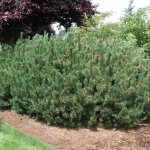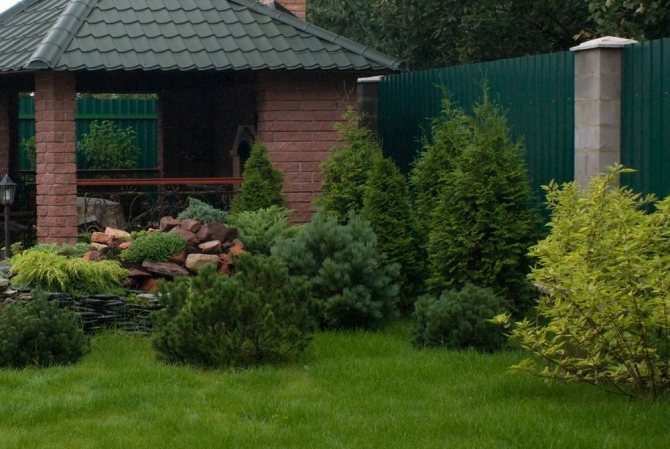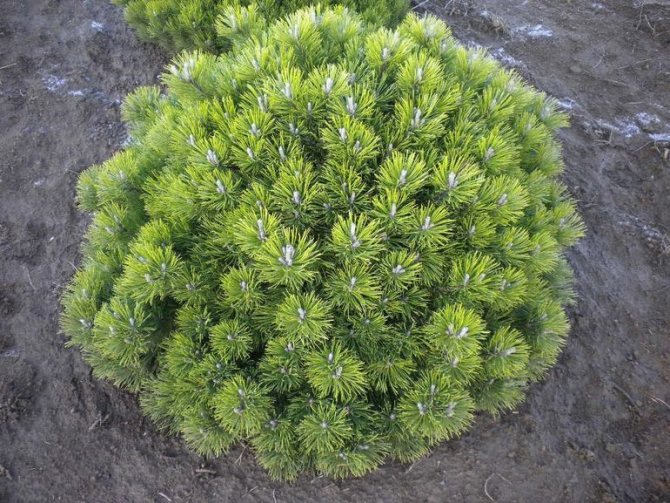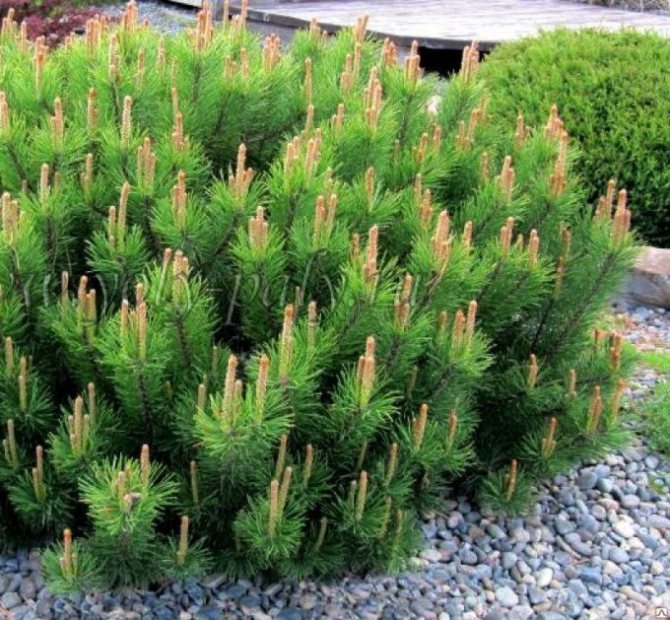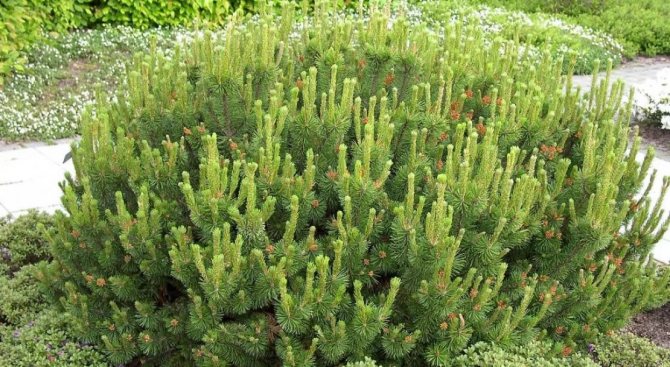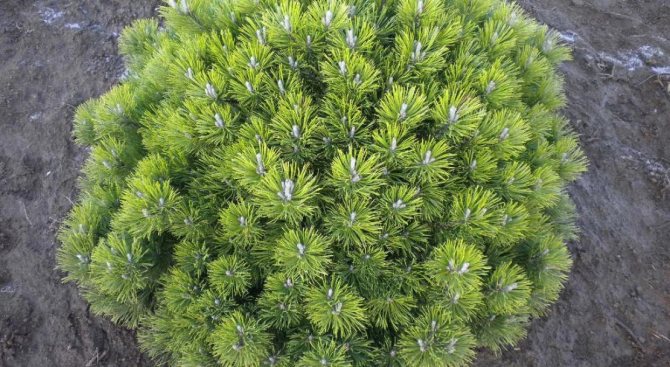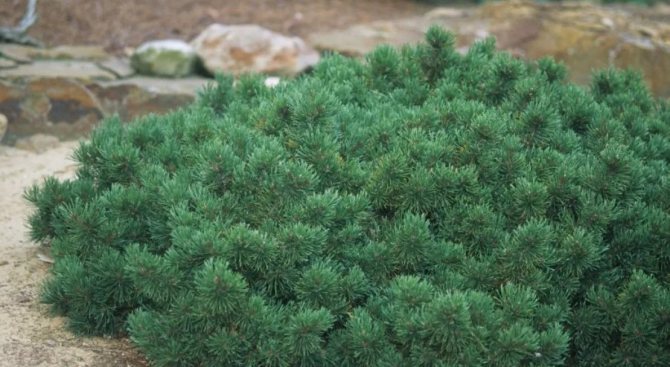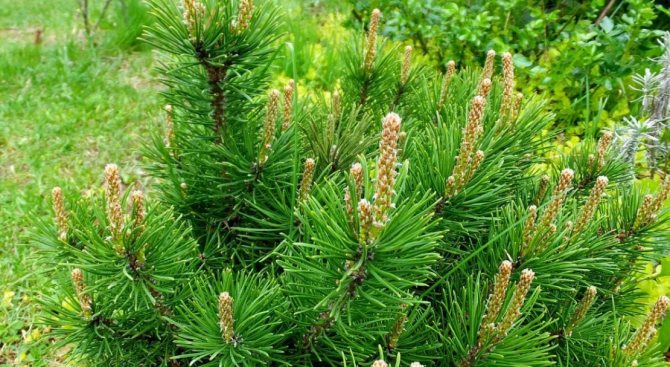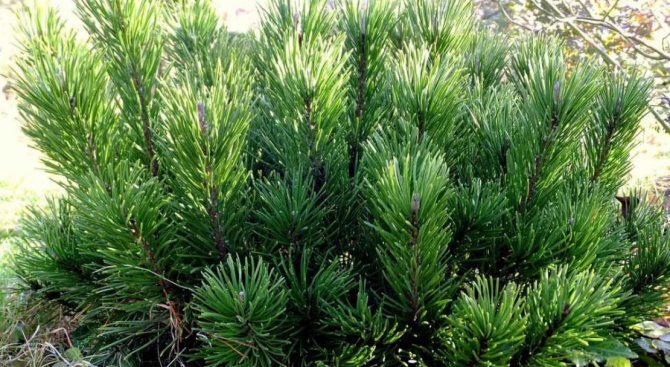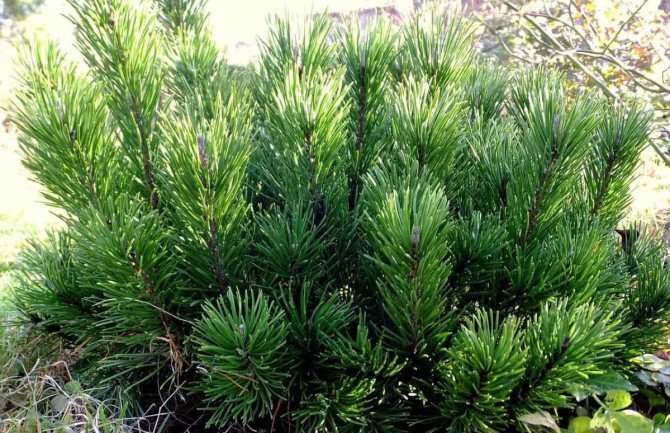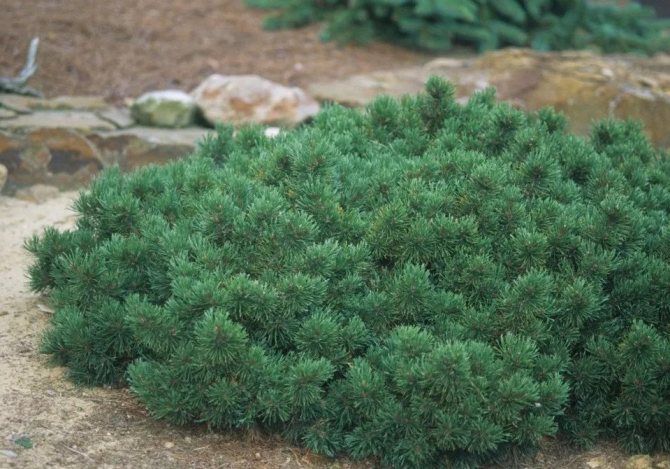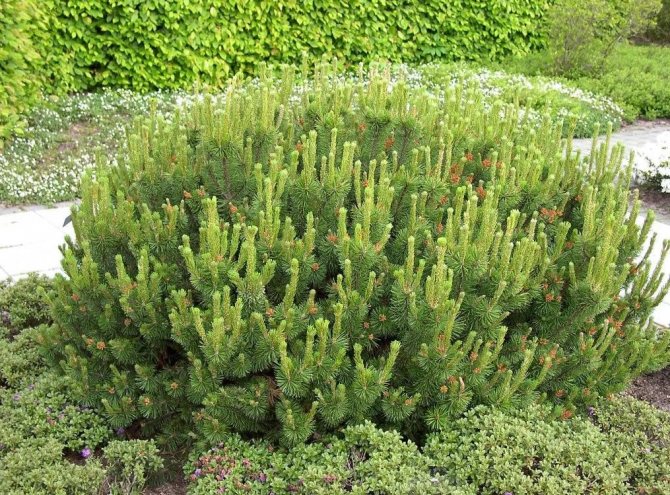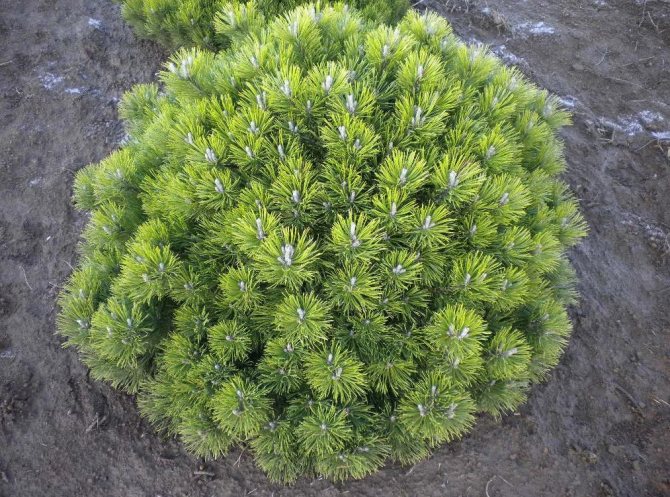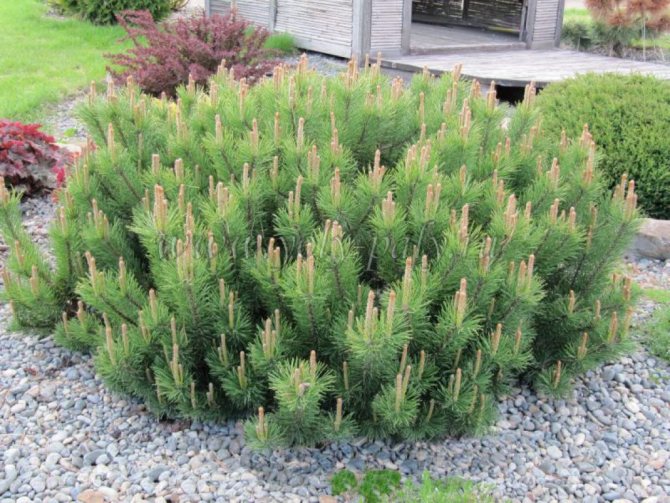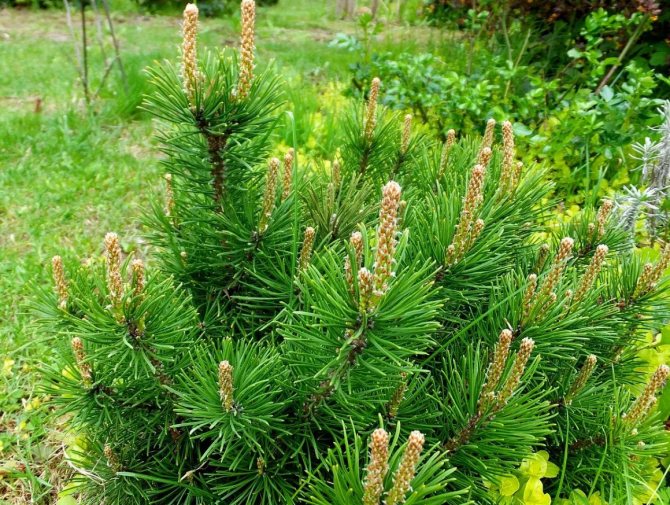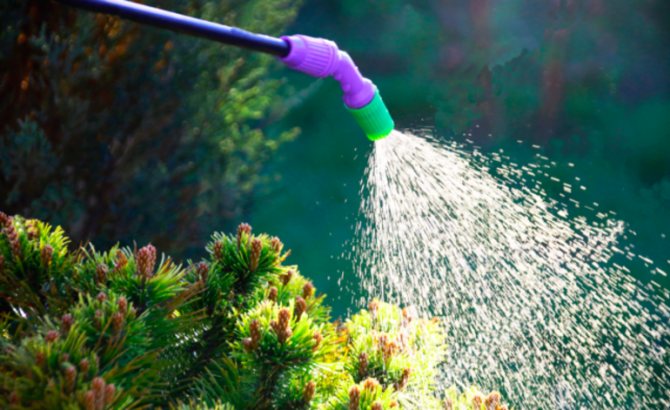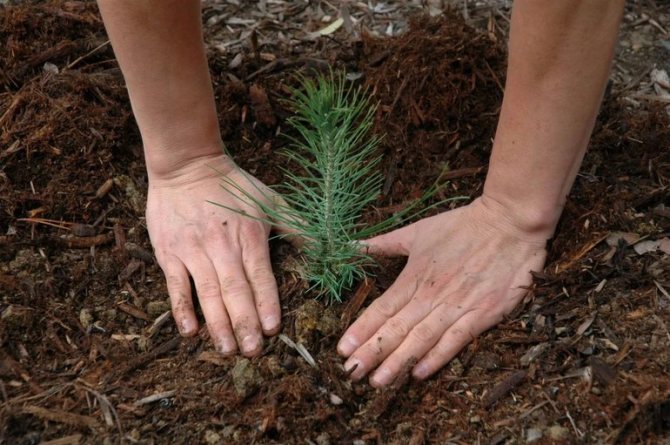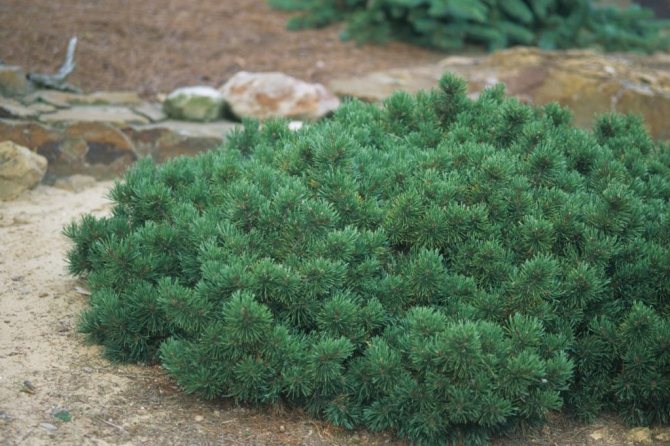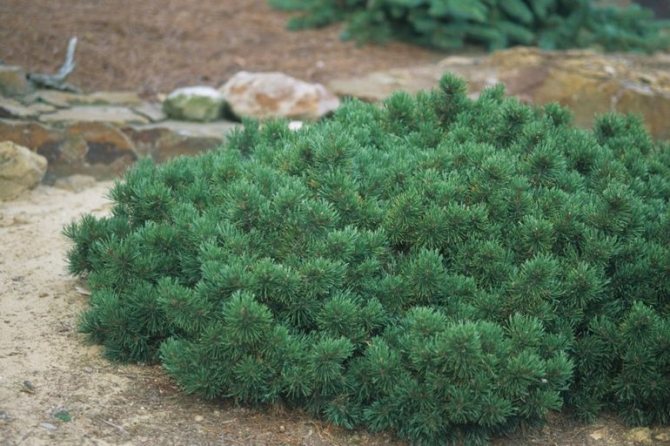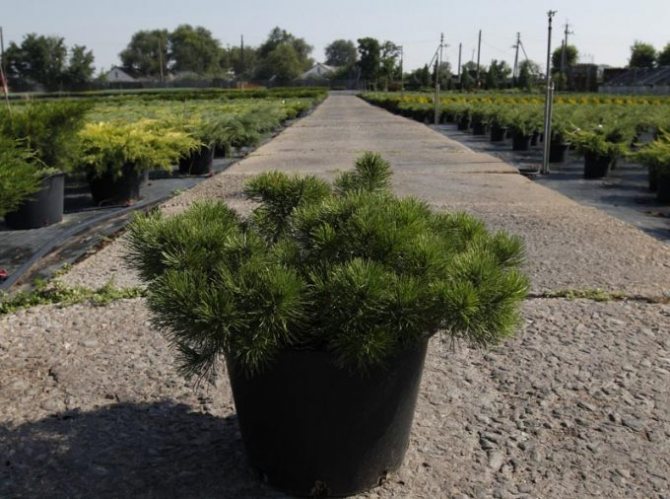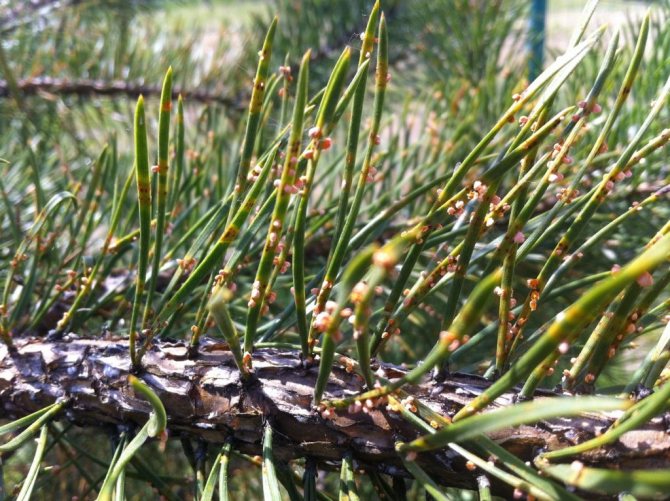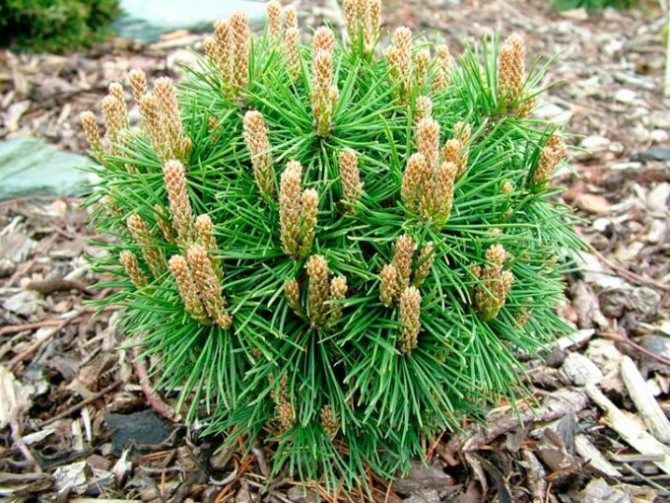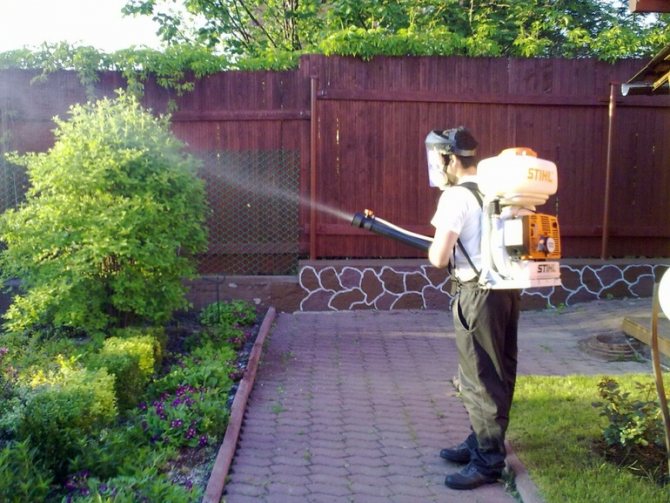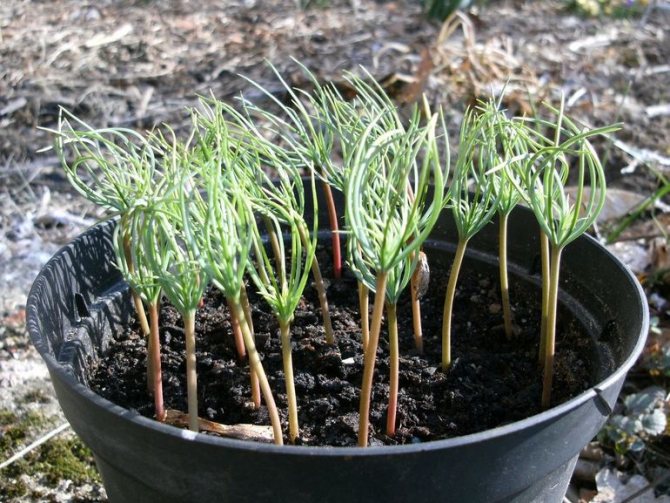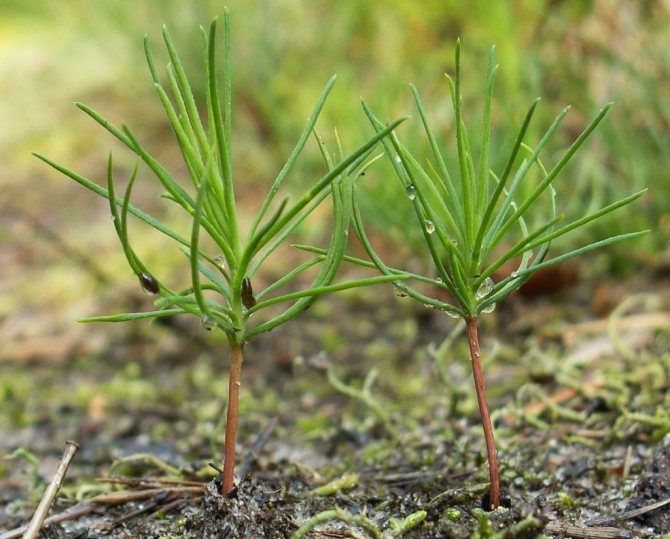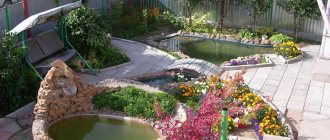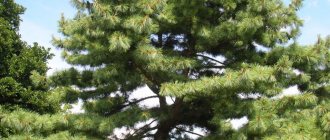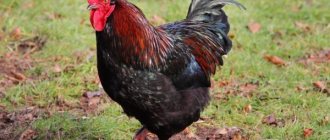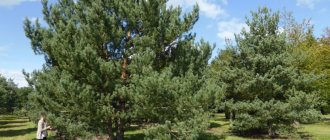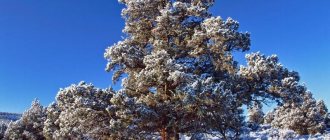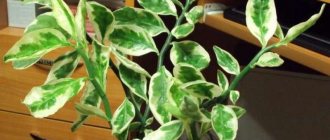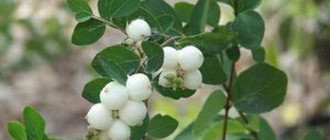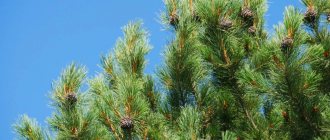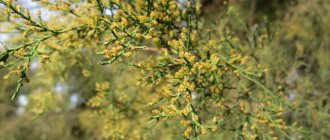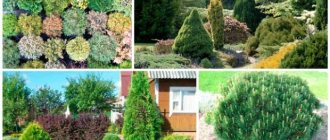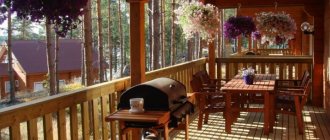Coniferous plant species are attractive for landscape design. This fact is explained by the fact that they create an atmosphere that is closest to natural conditions. Several varieties are used for landscaping, and one of them is the mountain pine Pumilio or Pinus mugo Pumilio. Another factor of popularity was the high rates of acceptance in the culture, which led to the appearance of pine in city parks and private plots.
Brief information about the variety
- Color: deep green.
- Height: up to 1 m.
- Crown width: up to 1.5 m.
- Growing regions: ubiquitous.
- Landing features: prefers places with good illumination and a drained, moderately moist substrate.
- Immunity: average, with improper care, predisposed to a number of diseases.
- Life span: 150-200 years
general characteristics
The mountain pine Pumilio (Pinus mugo var. Pumilio) is one of the dwarf species of conifers. As it grows, it forms a flat-round crown, which is characterized by branches densely located to each other. New young shoots are green, mostly directed horizontally.
The needles are relatively short, the size fluctuates around 3-8 cm. Bonded together in pairs. The kidneys are large, well distinguished from the rest of the mass.
The culture is considered to be slow-growing - by the age of 30, the crown width reaches no more than 1.5 m in diameter. At the same time, the height does not exceed 1 m. Due to such compact dimensions, the ephedra is allowed to grow not only in open ground, but also in pots.
In this case, the capacity should be selected so that the root system can develop in the same way as if it happened in natural conditions.
Cones are ovoid, located on a short petiole. In the young stage, they are blue, sometimes with a purple tint. The color changes to yellowish or brown one year after pollination.
Flowering occurs in the 6-10th year of the life of the bush, the exact time for opening the anthers depends on the region and climatic conditions. Often occurs before bud break on trees of a different species.
Growing regions
In its natural range, it grows in the mountains of Central and Eastern Europe, often found in the Alps and Carpathians. Feels comfortable even at an altitude of up to 2,600 m above sea level.
Due to its high frost resistance, it calmly tolerates climatic conditions characteristic of the winter months of the middle zone. It can be cultivated in more severe regions with heavy snowfalls, but in this case it needs to build special shelters.
Growing conditions
The mountain pine Pumilio grows best on sandy and loamy soils with an average fertility, but it is quite tolerant of other types of soil, including stony and calcareous. The only limitations are high compaction and severe waterlogging. The bush does not tolerate long stagnation of water. Therefore, the best option is to use drained soil for planting. Mountain pine is undemanding to moisture, acidity, salinity, nutrient content and other physicochemical parameters of the soil. It is quite tolerant to light compaction of the soil.
The plant is highly resistant to frost and drought, but does not tolerate shade well. However, Pumilio's sensitivity to low light is lower than that of the common pine. Another advantage of this coniferous bush is the ability to adapt to the polluted air of the urban environment.
Landing
With the correct location of Mugo Pumilio, it will not cause any particular difficulties and hassle in leaving.
The best option would be soils with moderate fertility, well-drained. However, it must be taken into account that groundwater close to the surface and systematic soil closure have a detrimental effect on crop health.
An important nuance when choosing a place of residence is the degree of illumination. Culture loves to bask in the gentle rays of the sun.
Sapling selection
It is better to buy a seedling in specialized nurseries, while following a number of nuances regarding the appearance of the plant.
Preference should be given to instances that have:
- a closed root system that does not show through the drainage holes of the container;
- crown, not exceeding the size of an earthen coma in projection;
- outwardly healthy branches and a well-moistened substrate (it is not recommended to buy plants with crumbling needles or needles that have changed color, which is the main sign of a past illness or complete death of a pine).
Site preparation
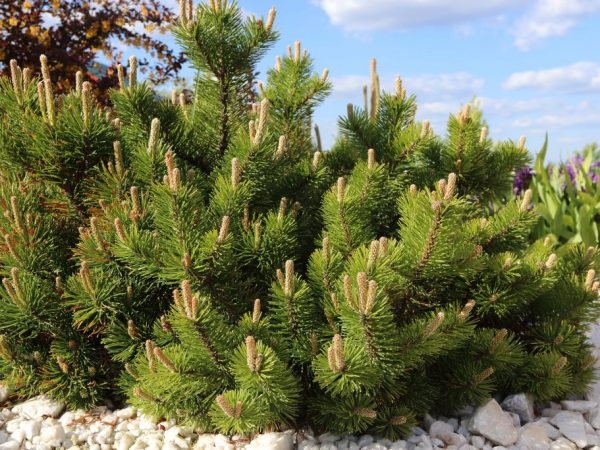
The plant is easy to care for
The planting hole is dug taking into account the location of the plant's earthen coma and the necessary drainage layer, which ideally reaches 20 cm in thickness.The average proportions of the hole are 70 cm deep and 1.5 m wide.
If the site is dominated by black soil or imported substrate, the soil mixture will have to be compiled independently. To do this, combine clay, river sand and sod land, supplement 200-300 g of lime.
It will not be superfluous to add 1 bucket of humus (exclusively leaf, and not obtained from the waste products of livestock) or nitroammofosk in the amount of 100-150 g.
Landing technology
- A drainage layer of crushed brick or pebbles is laid in a hole prepared in 2 weeks.
- Part of the substrate is poured. Place the seedling in the center so that the neck is flush with the surface.
- Distribute the rest of the soil. Ramp down.
- Watering.
- Mulch.
How to plant correctly
Pumilio is planted in a permanent place in March-April or early autumn. Transplanting of mature pines in winter is allowed. For transplantation, young seedlings are purchased - the optimal age is 3-5 years.
Soil preparation
Pumilio prefers moderately humid lands, grows well in coastal dunes and along the shores of lakes, rivers, swamps. It survives well in arid areas. Not afraid of acidified and depleted soils. To neutralize low PH, add:
- slaked lime;
- dolomite flour;
- limestone.
Pumilio needs well-lit areas, possibly light shading.
Landing
A depression is dug out in size 2 times larger than the roots of Pumilio. The hole is equipped with high-quality drainage in several layers:
- the lowest is gravel;
- medium - crushed red brick and expanded clay 20-25 mm in size;
- the upper one is coarse river sand.
If the pines are planted in a trench, the drainage system is laid along the entire length of the furrow.
The root collar is positioned flush with the ground. It is undesirable to deepen or raise it. For falling asleep, loose, light earth is selected. You can purchase a ready-made substrate for conifers in agricultural stores. The potting mix is made up of:
- 1 part slightly alkaline or slightly acidic turf;
- one part of peat;
- 1 part sand.
Gardeners recommend pouring needles collected in the forest into the recess. Helps to optimize soil acidity.
After planting, the plants are watered abundantly. The amount of water per plant is 10-12 liters.Gently tamp the surface of the trunk circle. Immediately mulch with sawdust or bark.
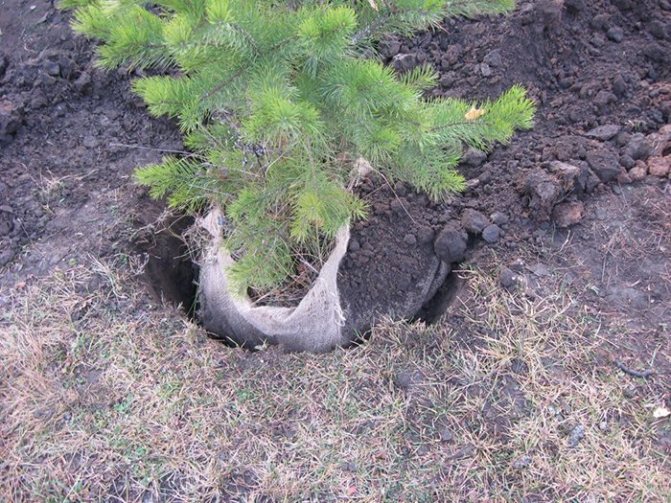

Care
Pinus Pumilio is not picky about soil moisture level or its composition. With equal success, it can grow both on personal plots and within the city due to its immunity to air pollution.
For a comfortable growth of a shrub, it is enough to adhere to some points in agrotechnical work, which will not cause difficulties in their implementation.
Watering
An adult Pumilio pine, unlike a seedling, is quite calm about drought. The shrub requires watering only for the first month, provided that it is planted in the autumn period or throughout the season, if it happened in the spring.
In order to ensure a comfortable wintering, the plant must be well moistened in the fall. Water the pine tree in several approaches so that moisture penetrates deep into the soil.
Top dressing
This ephedra is not a variety, but a subspecies, and after being removed from its natural range, it was practically not subjected to cultivation. Based on this, he does not need powerful feeding, with the exception of the first 10 years, until he gets strong enough.
When adding starter fertilizer to the planting pit, there is no need to take care of applying it in the next couple of years. In the future, an adult plant is fed for several years (seedlings are allowed for sale only after reaching at least 4 years of age).
The priority remains the spraying of the culture with special compounds. With their help, pine's immunity to aggressive natural conditions and the adverse effects of urban ecology increases, and decorative characteristics are noticeably improved.
Mulching and loosening the soil
Loosening of the surface layer is carried out for the first 1-2 years from the moment the seedling is planted. In the future, it is replaced by soil mulching, due to which the drying out of the substrate is minimized.
The material used is rotted wood waste, coniferous bark or peat. Fresh mulch chips are strictly prohibited.
Pruning
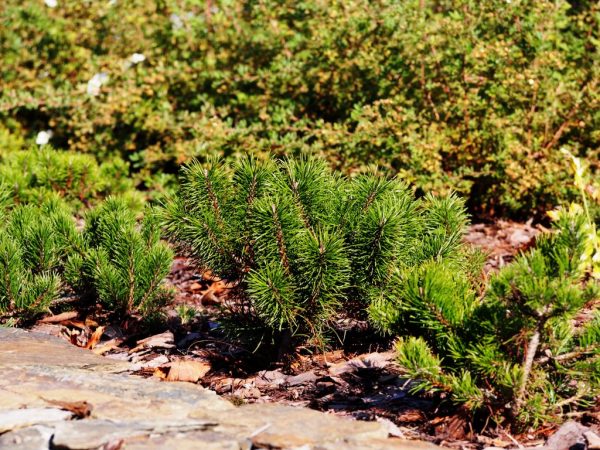

Crohn does not require formation
Pumilio does not require formative pruning. Sanitary correction of green mass consists in the elimination of dried branches.
Particular attention should be paid to the inner space of the crown so that no dead processes remain in it. The procedure is usually carried out until the kidneys open.
Preparing for winter
In adulthood, mountain pine can withstand frosts down to -46 °. Young specimens, on the other hand, are extremely sensitive to lower temperatures and need shelter during the first year of life. Agrofibre or spruce branches are used for it.
Additionally, the soil is mulched with a layer of at least 7 cm in thickness. The exception is the regions where the mark does not fall below 0 ° in winter.
If the shrub grows in an area with harsh conditions, it is necessary to provide culture for the next year as well. In climatic zone 2, the event is carried out for up to 10 years.
Preparing for winter
The Pumilio species tolerates winter temperatures down to -45 degrees. If the plant is mature and well-rooted, it does not need shelter for the winter. In the first years after planting, it is necessary to prepare the pine for winter:
- Cover the plant with white agrofibre. If there is no covering material, spruce branches are used.
- The soil around the trunk is covered with mulch with a layer of 7-10 cm.
- If the plant is planted in a region with warm winters, there is no need to mulch the soil.
- In cold areas, the plant needs to be insulated up to 10 years of age. If we assume that the seedling spent the first 5 years in the nursery, the procedure must be repeated for another 5 years after planting.
Reproduction
There are several ways of breeding miniature pine: grafting, by means of seeds or cuttings.
If you are not a professional in this matter, the best option is to use seeds (it is quite possible to collect them yourself). This approach allows you to completely preserve the decorativeness of the mother tree and is almost always crowned with success.
Seed is collected in November at the end of the pollination process. In the future, they are subjected to stratification for 4-5 months. Seed germination is about 35% of the total.
First of all, the prepared seeds are embedded in a light soil mixture and constantly monitor its moisture content. When sprouts appear, they dive into separate containers and keep at home for 4-5 years.
In the case of propagation by means of cuttings, young shoots are used, on which a heel is left - part of the bark of the mother tree. They are first placed in water for a couple of hours, then kept in a preparation to stimulate growth. Then they are planted in the ground, embedded to a depth of 5 cm.
They also create greenhouse conditions. A manure pillow is considered not superfluous, which provides a gentle plant with the necessary warmth.
The vaccination method is the least successful. For him, 1-3-year-old shoots are grafted onto seedlings that have reached 4-5 years.
Diseases and pests
The cause of diseases and insect attacks lies in improper care and systematic overflow of the plant.
Pests that can cause serious damage to shrubs:
- mealybug;
- pine scale;
- aphid hermes;
- pine scoop.
You can get rid of the misfortune by spraying the crown with insecticides.
Of the diseases, mountain pine especially often suffers from resin cancer. A lot of discomfort is caused by rot, formed during excessive watering of the crop and affecting not only the branches, but also the root system.
Fungicide-based products help to solve the problem. In order to prevent the disease, it is recommended to carry out regular prophylaxis and inspect the tree by period.
We take care of mountain conifers
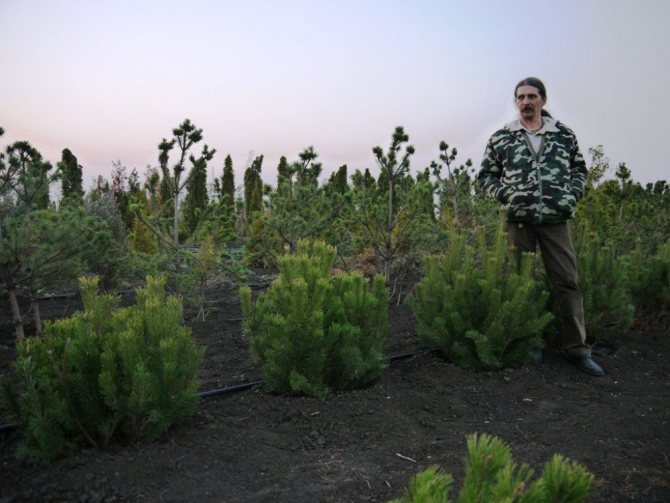

Mountain pine is an unpretentious plant. It is necessary to additionally water the pines on especially hot days, in the first year - once a week. After watering, slightly loosen the soil around the trunk.
- Plants should be fed once a year with complex mineral fertilizers;
- Young plants for the winter must be covered with non-woven material or spruce branches. The shelter is removed in April when the snow has completely melted. To prevent the needles from acquiring rusty shades, at the end of winter, all trees must be closed from the sun. In the same period, pruning of branches should be carried out, as well as dried branches should be removed. Mulch is able to retain moisture for a long time, and also improves the structure of the soil. Mulching before the beginning of winter is a common thing; as the main material, it is better to pick up spruce branches or chop the old, but healthy bark of trees. Such harvesting does not attract the attention of field rodents, and is also able to prevent deep freezing of the soil and avoid the death of a pine seedling.
Use in landscape design
Pumilio pines help to solve a considerable range of design problems. The plant looks great in the parterre or on the terrace, it favorably emphasizes the sophistication of various flower beds and rocky gardens.
However, due to the small size and green tint of the needles in landscape design, the variety is rarely used in single copies or in groups, because it can get lost against the background of other plants.
Also, when locating a culture on a site, it should be borne in mind that, despite its compact dimensions, it will become much larger with age, and a mature tree does not tolerate transportation.
Pine diseases
As you already know, with this plant everything is simple: use, and planting, and care. Mountain pine is extremely popular, because for a long time it pleases the eye, while requiring a minimum of maintenance.In addition, the Pumilio pine is resistant to various diseases, which cannot be said about other conifers.
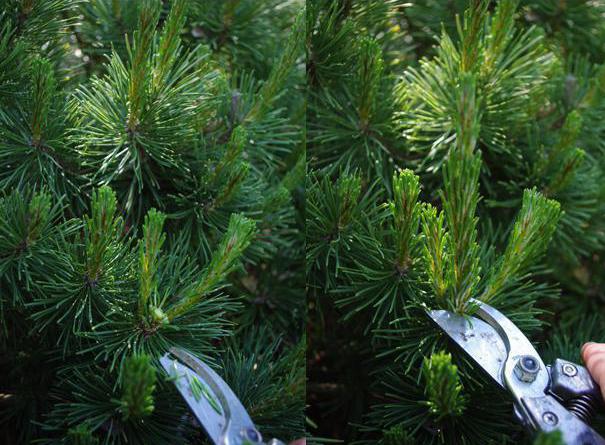

The only problem is fungal disease. Schütte disease is characterized by blackening of the branches and rapid drying of the needles. Coping with this scourge is easy - you should treat the plant with a fungicide.
But if this disease appears in a plant in the first 3 years of its life, most likely the seedling will die. Therefore, seedlings should be purchased from proven horticultural associations.

